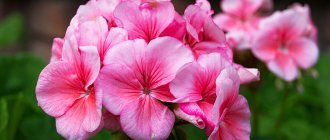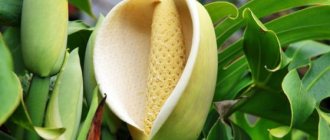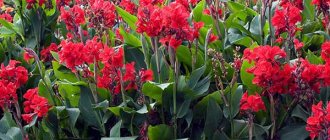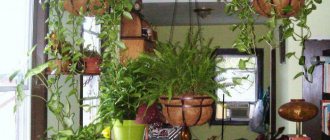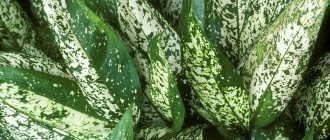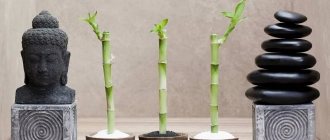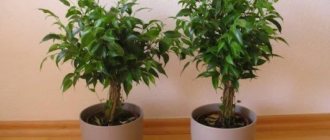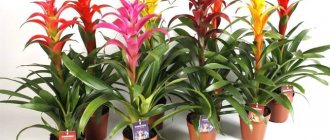You won’t find a more bizarre leaf shape than that of Platycerium. At the very least, this is definitely the most original of ferns. His special appearance is combined with an equally special character. Like all epiphytes, platycerium is very demanding on air humidity and temperature conditions. But there are even more norms and rules for care, because this fern does not forgive mistakes. For the platicerium to become the main pride of the collection and only bring joy, it will have to be surrounded with love and care. And you won’t be able to limit yourself to just diligent watering.
Platycerium is a staghorn fern for the discerning gardener. © terravivaflores
Deer horns. Description of the plant
The antler flower (photos are presented in the article for cultural reference) is a large epiphytic plant with branched roots located in the upper zone of the leaves and under the root scales.
Deer antler flower
Leaves may be spore-bearing or sterile. The latter is characterized by a wide size, spreading and round shape. The leaves fit rather tightly to the branches and trunk with a loose upper edge. It forms a niche into which precipitation falls along with debris from dying fern leaves.
Over time, enough humus accumulates in the niche to serve as a substrate for the roots of cultivated plants.
The spore-bearing leaves are located on short petioles and are characterized by a flat shape and a dense cuticle. Leaves are erect. When the green mass hangs down, it resembles antlers. Sporangia control plant reproduction and photosynthesis. They are located at the top of the leaves, giving the lower part a reddish tint.
Types of Platycerium home
There are 17 types of Platycerium, some of them are the most popular in indoor culture.
Platycerium bifurcatum (Platycerium bifurcatum)
It has rounded sterile fronds with a radius of up to 0.1 m. They press against the soil and retain nutrients and moisture. After decomposition, they themselves become a source of nutrition for the plant. Spore-bearing fronds, divided into parts 40 mm wide, look like deer antlers. Their length reaches 0.5 m. They are assembled into a socket.
Platycerium grande
The height of the fern is 0.25 m. The fronds do not have clear cuts. Elongated spore-bearing fronds hang down, their length is up to 1 m. Sterile fronds are wide – up to 0.6 m.
Platycerium Hillii
Forms numerous straight leaves with shallow cuts. Some lobes are shorter than others and their edges are pointed. Outwardly it resembles Platycerium bifurcata, but is smaller.
Platicerium is a relict plant that surprises with the bizarre shapes of its leaves. The fern, attached to driftwood or grown on a stump, seems to have come into the house from an old fairy tale. An unusual plant will decorate the interior and emphasize its originality.
Plant conditions
Growing in an apartment does not require much labor. Just follow agronomic standards, and then you can grow a beautiful, lush bush.
Lighting
The flower loves bright light, but it must be protected from sunlight. If the rays hit the green mass, it may burn. To do this, it is preferable to place the container with stems on the western or eastern side of the house. It is necessary to provide sufficient sunlight for the crop. Otherwise, the green mass will become thin, sag, darken and lose elasticity.
Temperature
The crop should grow comfortably at temperatures between +20 °C and +25 °C. It is not recommended to reduce the usual values, as there is a risk of root rot. A decrease in temperature is allowed in the winter season, when the indicator will fluctuate between +14 °C - +17 °C.
Humidity
Good humidity is one of the most important criteria for this crop, since this plant is native to the tropics. Humidity in the house should fluctuate around 80%. To maintain this level, constant watering with small drops is required.
A humidifier and a tray of damp expanded clay placed next to the container can help. This will help maintain the desired humidity level. If air humidity is low, the condition of the fern will worsen.
Soil and drainage
To grow Platycerium, you can use a suitable layer of soil in which orchids are grown. It can be bought at any flower shop.
However, for the full development of flower culture, a mixture of the following ingredients is suitable:
- One part each of moss and crushed pine bark.
- Several parts of leaf soil and an equal amount of washed river sand;
- 4 parts of high-moor peat;
The flower develops rather slowly, so it needs a small container, slightly larger than its roots, made of any material.
Watering
For watering, use soft liquids at room temperature. The top layer of soil should be moistened when the top layer first dries. Avoid overwatering as this can cause root rot. Water less often in winter.
Growing conditions for indoor platycerium
Shade-tolerant and heat-loving, platyceriums require careful selection of a place in which they can stay for many years. They adapt poorly to changes and moving, especially at the age of 3 years.
Lighting and placement
Platycerium requires a lot of space; the leaves should hang freely and not rest against glass or other surfaces. Even if the fern is growing in a pot, it is worth placing it on a stand or with the leaves hanging over the edge of furniture.
To admire the luxurious forms of platycerium, you need to find a place with uniform, soft, diffused light. Direct sun is destructive, and with slow adaptation it is an amazingly shade-tolerant fern. Diffused bright light near the eastern and western windows, a northern window sill or partial shade away from the southern windows are ideal options.
When choosing a place, you need to take into account the recommendations when purchasing: platyceriums do not adapt well to changes in lighting, the conditions in the new house should be close to the usual ones.
Methods of growing and propagating plants
The stem can be propagated at home by seeds or vegetatively by separating the apical shoot in the spring. Its length should be at least 10 cm. The seedling should be rooted in peat and sand and kept under a plastic cover in a bright place.
When transplanted, it can be propagated quite easily and quickly by dividing the rhizomes. The most labor-intensive method is sowing spores. To do this, use small pots, into which you should add a drainage layer with a nutrient mixture based on leaf soil, peat and sand.
How to grow a plant: step-by-step instructions
It is recommended to grow the Deer Antler flower (the photos will help beginners grow the plant and choose the optimal place for it at home) from seeds from January to March.
To do this, follow the instructions below:
- Spread the seeds on the surface of the soil layer, pressing them lightly, but not covering them.
- The seeds should be placed in a warm place and the container covered with plastic or glass. Make sure there is shade. This can be done with a light curtain or paper.
- Caring for seedlings is easy; just ventilate the container several times a day and water if necessary.
- For seed germination, a temperature of +16 to +18 °C is required. Glass with shading material should be removed after the first shoots appear.
- The seedlings will need to be harvested after 5 weeks and covered with plastic wrap for 3 days. After several leaves appear, the seedlings should be transplanted into separate pots with a diameter of up to 8 cm.
Plants bloom within 12 months after sowing the seeds.
Temperature and lighting
The exotic flower grows poorly and withers under the bright rays of the sun. It is better for diffused light to fall on it. The optimal place for a pot or flowerpot with a beautiful fern is a western or eastern window sill. If the plant has a place only on the south window, it is advisable to move it into the shade at noon until the evening. During the winter season, additional lighting is required. It is organized by installing special phyto-lamps. The exotic begins to hurt if it stands in a draft or in a too stuffy room. It needs frequent ventilation and an air temperature not higher than +20-25 degrees in the spring-summer period, and in the autumn-winter period - not lower than +16 degrees.
Plant propagation instructions
Propagated by division in accordance with the following points:
- First, carefully inspect the bush and determine the places where pruning is permissible. They should be placed in such a way that each specimen has healthy and complete roots and leaves.
- Then make cuts with a knife previously soaked in alcohol. After making the cuts, cover the cut areas with wood ash.
- Then separate each part of the plant into separate containers.
This method of reproduction is the simplest and most effective. Over time, the flowers form a daughter bush, which cannot develop separately from the parent rosette. Gradually it will get stronger and begin to grow roots. At this point, the offspring will need to be carefully separated from the crop and planted in a separate container. The advantage of propagation is that the parent bush does not need to be replanted.
Step-by-step algorithm for propagating Platycerium using spores:
- Spores should be collected from the back of the spore-bearing outgrowths. Then they should be left for a while to dry thoroughly.
- Next, prepare a small container and fill it with a layer of mature potting soil.
- Then water the soil thoroughly and place the spores on the surface without submerging them in water.
- Cover the container with film or glass to create greenhouse conditions.
- The container should then be placed in a warm, bright place.
- The greenhouse should be constantly ventilated, and if necessary, moisten the soil layer using a sprayer.
- 42 days after the first shoots appear, the glass or foil should be removed.
- When the seedlings grow up, they will need to be planted in separate pots.
This distribution method is quite complex and is therefore rarely used. The advantage of this method is that several new seedlings can be obtained at the same time.
Features of reproduction
Platycerium fern: propagation
These ferns can be propagated either by spores (which is done extremely rarely in amateur floriculture) or by separating shoots.
Platycerium shoots usually appear at the base of the bush. To plant a new shoot, it must already have roots and at least three small leaves, including a sterile corymb. Carefully, using a sharp knife, the baby is separated from the mother plant and planted in a new pot prepared in advance.
Attention! It is important to ensure that the growth bud is above the substrate level.
After transplanting, the baby needs to be covered with polyethylene for at least a week so that the plant takes root in this mini-greenhouse.
Preparing the soil for replanting
For replanting, the staghorn flower requires a small container, which will be slightly wider than the previous one, but of the same depth. Growing photographs will help gardeners prepare the substrate correctly.
Preparing the soil for replanting:
- First, the pot must be filled with a layer of drainage. Chopped brick or expanded clay are suitable for this. Drainage prevents moisture stagnation.
- Then the container should be covered with a layer of soil. A mixture used for ferns or orchids will be suitable.
- If necessary, a small amount of charcoal can be added to the soil.
You can make your own potting soil. Mix turf with leaves, sand and peat. The ingredients must be mixed in equal quantities. Make sure the top layer of soil is slightly acidic.
Step-by-step instructions for transplantation
When replanting, all actions must be careful, since the flowering plant is difficult to tolerate various damages.
Step-by-step instructions for replanting flowering plants:
- The flower must be carefully removed from the old container, preserving the old lump of earth. Transplantation should be carried out using the transshipment method.
- Then the plant should be transplanted into a new pot with prepared substrate.
- Cover any remaining empty spaces with fresh potting soil.
- When finished, sprinkle with water.
Why does the plant dry out and turn yellow?
A flowering plant may become diseased or turn yellow if not cared for properly. Eventually, it may wither completely.
Wilting can be caused by several factors:
| The plant begins to wither | Leaves begin to turn yellow |
| The soil is moistened too little or too often | The temperature in the room where the flower is located reaches above +25 °C |
| The room temperature is very low. | The crop is exposed to direct sunlight |
| Exposure to cold drafts | Excessive fertilization. |
| Watering with chlorinated, hard or cold water. |
Useful properties of platicerium
Platycerium purifies indoor air, neutralizing the harmful effects of gaseous hydrocarbons - propane, methane, butane, ethane (many of them enter the room through open windows from the street). Plant cells secrete phytoncides - antibiotics created by nature.
These volatile compounds purify the air of harmful microorganisms and saturate it with beneficial ions.
Pest and disease control
Most problems with indoor plants arise from poor maintenance or improper care. It is necessary to monitor the condition of the crop and take into account negative influences. If the air is too humid, the stems become covered with gray mold. It appears as brownish spots on the leaves. Succulents should be treated with a special antifungal drug. Leaf spot is another fungal disease that can occur on the plant.
Symptoms include small yellowish spots on the leaves that gradually turn brown. Infected leaves fall off. The fungus must be controlled with fungicides.
One of the dangerous pests of flowering plants is lepidoptera, which is resistant to insecticides and can cause great harm to the crop. The infected plant should be isolated from other vegetation, treated with a solution of laundry soap and insects removed.
Then four consecutive treatments should be carried out at intervals of 1 week. If the infestation is severe, insecticides must be used. The plant may be damaged by mealybugs, which can be removed using a soap or alcohol solution followed by an insecticide. It is recommended to spray the leaves with mineral oil.
Fertilizers for plants
The Staghorn flower (the photo will tell the gardener how to grow the plant at home) is considered an unpretentious crop that does not require constant addition of mineral or organic fertilizers. If the plant is overfed, it will grow slowly and stop blooming. In the end, he may die.
Mineral mixtures
The plant should be fertilized no more than once every 30 days. Due to its slow growth, the plant only needs a small amount of fertilizer. Absolute can be used as a complex fertilizer. The solution should be prepared in accordance with the instructions included with the drug. The concentration should be reduced by 2 times. Fertilization should be carried out from April to September, since the rest of the time the flowers are dormant.
Organic fertilizers
Gardeners recommend placing scalded tea leaves or banana peels under the dome, which form a sterile green mass. The procedure should be performed twice every 7 days.
General information
The plant has two types of fronds - sterile and spore-bearing. At the bottom of the fern, sterile fronds grow, which remain green in the fall, but dry out and turn yellow in the spring and summer. It would be a big mistake if you decide to trim them. These leaves are an important source of nutrition for the roots.
Spore-bearing leaves begin to perform their main function late - the fern must be at least five years old. These fronds are covered with white threads, which serve as protection from light and protect moisture.
Possible difficulties in growing
Some difficulties may arise if cultivation is carried out on a flat area. The plant needs a lot of moisture in the air. However, this is difficult to achieve indoors. Therefore, you will need an air humidifier, use a tray with expanded clay and spray the crop with finely divided drops. Plants need a lot of light.
With a lack of light, the leaves turn yellow, wither and fall off. If your apartment or house receives little sunlight, you will need additional lighting in the form of lamps.
If the air humidity is high and the flower does not have enough water, the leaves wither and fall off. To improve the situation, it is necessary to adjust the watering regime. If a plant is overfed with organic compounds, it stops blooming. To solve this problem, temporarily stop fertilizing. If a plant is slow to flower and loses its leaves after flowering, it needs more fertilizer.
Caring for Platycerum at home
Do not underestimate the moisture-loving nature of platyceriums, which is easy to guess from their growth pattern. Platycerium does not tolerate dry soil or dry air.
Watering and air humidity
It is quite easy to establish a comfortable watering regime for platyceriums: the substrate must be kept slightly moist at all times, watering as soon as the soil dries out from above, immediately draining the water from the trays. Complete drying of the substrate is destructive, but if it is over-moistened, rot easily spreads. You can water platiceriums in the same way as orchids - by immersing the pot in water or from above, carefully, into the cracks on the bed of barren leaves.
For this fern, you need to create a contrast between the summer and winter periods, reducing watering by half during the dormant period. Only very soft water is suitable for platycerium.
The minimum humidity at which the plant will retain leaves is 50%, and even then with very slow adaptation. For the greatest decorative effect and active growth, it is better to maintain indicators of 75-80%. Spraying is unacceptable; horn-shaped leaves cannot be soaked. For the platycerium you will have to install humidifiers (both appliances and home alternatives are suitable). It is appropriate to group flathorns with other moisture-loving crops (especially orchids).
Top dressing and fertilizer composition
Platyceriums do not like increasing the concentration of fertilizers and excessive fertilizing. It is better to apply fertilizing with water for irrigation, halving the dosage recommended by the manufacturer. The standard frequency is once every 10 days.
For platycerium you can use:
- fertilizers for ferns or decorative foliage plants;
- mineral and organic fertilizers in turn.
Pruning and shaping platycerium
You need to be very careful when removing damaged, dried platycerium leaves. Barren brown leaves should not be touched even when transplanting, they must remain on the bed, and the more carefully they are handled, the better. But spore-bearing leaves are cut off as usual, to the base or healthy tissue.
Signs and superstitions about the flower
Antlers are often grown at home. However, when we rely on fortune telling and superstition, the plant is treated differently:
- the plant is often called wormwood, accusing it of provoking husbands to cheat.
- This flower helps protect against harmful radiation, influences career growth and attracts good luck;
- culture feeds on the energy of family conflicts, provoking them in rare cases;
In general, however, antler flower has a very good effect on people. Only culture should not be placed in the bedroom. This is because fern plants are capable of releasing small amounts of toxic substances that can cause headaches and nightmares in very sensitive people. Photographs of the crop will tell you where it is best to place a pot with a plant so that it brings happiness and benefit.
